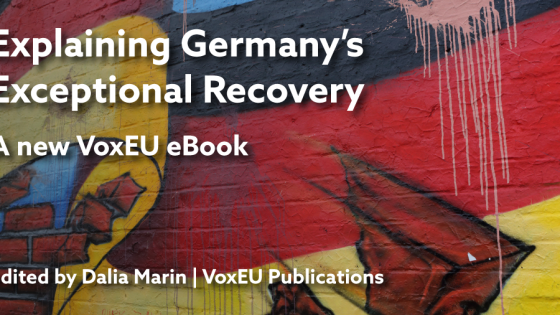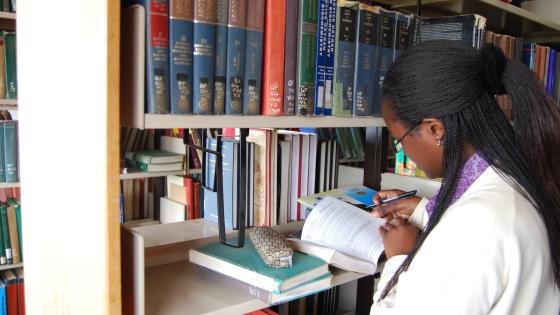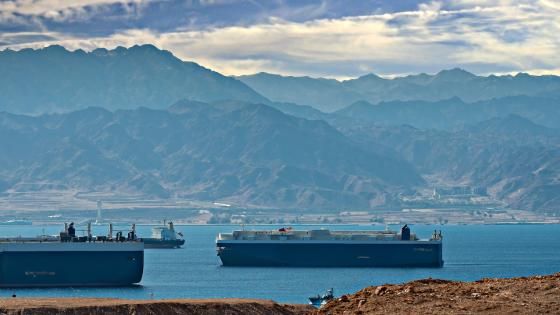In the late 1990s Germany was called ‘the sick man of Europe’ (Bertram 1997). Today, Germany is an ‘economic superstar’. Unemployment declined from 13% in 2005 to 6.1% in 2016. Germany is one of the world champions in exporting, accounting for almost 8% of world exports. A new eBook explains how Germany‘s extraordinary recovery came about (Marin 2018).
Download the Vox eBook Explaining Germany's Exceptional Recovery here.
The astonishing transformation of Germany’s economy happened at the same time as international trade with Eastern Europe was liberalised after the fall of communism. This event profoundly changed the way firms and workers operated. Trade liberalisation with the formerly planned economies after the fall of communism led to decentralised wage bargaining lowering wages; to a decentralised, less hierarchical management style in firms improving the quality of German exports; and to the expansion of production networks to Eastern Europe lowering costs; and finally it allowed Germany to absorb the ‘China shock’ more easily than in other countries, in particular the US.
The institution of labour relations
One leading explanation for Germany’s recovery is the astonishing transformation of Germany’s industrial relations from a rigid system of national wage negotiations to a decentralised flexible system of wage bargaining at the firm level as Dustmann et al. and Baccaro argue in Chapters 1 and 2 of the eBook. This led to a dramatic decline in unit labour costs and to an increase in competitiveness. The decentralisation of wage bargaining was triggered by the new opportunities to move production to the emerging market economies of Eastern Europe. This changed the power equilibrium between trade unions and employer federations and forced unions and work councils to accept deviations from industry-wide agreements. Dustmann et al. emphasise that the ‘Hartz reforms’ – commonly viewed in Germany as the critical turn around for the economy – played no essential role in this process, which had started a decade before (see also Dustmann et al. 2014). Baccaro points out that the old, rigid, high-cost system of wage bargaining may have had its advantages by acting as a ‘beneficial constraint’ which forced firms to upgrade the quality of their products to stay competitive in world markets (see also Streeck 1997).
Globalisation and technology
Marin argues in Chapter 3 of the eBook that wage moderation cannot explain Germany’s more recent success in exporting. After the financial crisis exports in Germany rebounded more quickly in spite of more rapid increases in wages compared to other European countries. Trade liberalisation with Eastern Europe had a profound effect on Germany’s way of doing business (see also Marin and Verdier 2014). Firms reorganised to a more decentralised, less hierarchical style of management which provided workers with incentives for product quality. Workers at lower levels of the firm hierarchy are better informed about market demands. Giving these workers more autonomy in decision making encourages firms to introduce products that customers appreciate. Marin finds that decentralised management contributed to large gains in export market shares (see also Marin et al. 2015). This way, the high-cost industrial labour regime before the 1990s may have had a lasting effect on a business culture of quality (‘Made in Germany’) that persisted even when the disciplining role of high wages and a strong Deutsche Mark vanished.
The opening-up of Eastern Europe after the fall of communism also affected German business in another way: German firms expanded production networks to Eastern Europe. Eastern Europe was rich in skilled labour and this offered not only new market opportunities for German firms, but also a pool of skilled and inexpensive workers. This helped Germany to cope with a skill shortage which became particularly acute in the 1990s. Offshoring to Eastern Europe lowered costs and helped to win market shares globally (Marin 2010).
Trade liberalisation with Eastern Europe was also a driving force behind Germany absorbing the China shock so much better than the US, as Suedekum emphasises in Chapter 4. The job losses from import penetration from China following its accession to the WTO were more than offset by additional jobs which were created from rising export opportunities to Eastern Europe. China’s rise has a different effect on Germany than the rise of Eastern Europe, because these two trade shocks are quite distinct. Trade with China is of the inter-industry type (trade across sectors, e.g. cars versus textiles), while trade with Eastern Europe takes place within the same sector (intra-industry trade, e.g. BMW versus Skoda) and within the same multinational firms (intra-firm trade, e.g. car parts versus cars) (Dauth et al. 2014).
Moreover, Suedekum finds that robots had a milder effect on Germany’s labour market compared to the US. The reason is Germany’s particular way of coping with technical change of retaining and retraining incumbents. This way, the robots did not raise the displacement risks for incumbent workers but have replaced potential jobs for young labour market entrants.
The more favourable labour market conditions in Germany may explain why, in Chapter 10 of the eBook, Cantoni et al. do not find that globalisation and increasing job insecurity have contributed to the rise of the vote for the far-right. Somewhat worryingly, they identify a stunning historical persistence in voting behaviour: municipalities with high vote shares for the Nazi party in the 1920s-30s also had higher vote shares for the AfD in the 2016/17 state elections. Cantoni et al. identify this correlation after 2015 – the time when the conservative, anti-immigrant members took over the leadership of the party – and not before. They rule out other explanations of the vote for the far-right such as the inflow of refugees to Germany in 2015. They see the success of the AfD as the result of a political supply shock rather than a backlash against economic policies.
Harhoff and Schnitzer point out in Chapter 5 that the loss of human capital and talent after WWII did not create the initial conditions for long-term growth in Germany. Only after 2005 did R&D spending start to rise substantially and the government start an initiative to rejuvenate German universities. They also identify a lack of entrepreneurial dynamism in the German economy.
The current account surplus
With almost 8% of GDP in 2017 Germany has the largest current account surplus in the world. There are two possible sources for the large surplus: large exports or low imports. Chapters 1 to 3 of the book show that Germany is indeed a very successful exporter because of low wages (via decentralised wage bargaining), excellent product quality (via decentralised management in firms), and low production costs (via offshoring to Eastern Europe).
In Chapter 6 Wolff focuses on the import side of the current account. From a national accounts perspective, a country will face a current account surplus if its savings are large and its investments are low. Many of the investment goods are imported. Therefore, little investment leads to low imports. He finds that the German current account surplus is mainly driven by low corporate investments, which are lower than in Italy and France. He suggests that the government should increase public investment (to address the low intangible capital stock that he documents) and should encourage private investment.
In the mid-2000s Germany introduced a mix of taxes which may have shifted relative prices and the external balance in Germany’s favour, as Ghironi and Benjamin Weigert explore in Chapter 7. Germany combined an increase in the value-added tax with a decrease in the payroll tax. This menu of taxes corresponds to a fiscal devaluation which is equivalent to a depreciation of a country’s currency, as has been shown recently (Farhi et al. 2014). Absent the ability to devalue the currency in a monetary union, countries may introduce this mix of taxes to depreciate their currency. Ghironi and Weigert then ask whether Germany did in fact pursue a fiscal devaluation to improve its external competitiveness. Their answer is no, because policymakers did not intend to use the policy mix to change Germany’s external competitiveness, but rather to address domestic problems such as the reduction of distortions in the economy and the need to preserve tax revenue.
The role of history
Chapters 8 and 9 of the eBook turn to a different topic – why Germany’s way of operating often leads to tensions in the euro area. Wyplosz argues that with the Maastricht Treaty Germany became the de facto leader of the euro area. The treaty delivered central bank independence and low inflation compared to previous years. This worked until the financial crisis. The unwillingness to act as a lender of last resort transformed the banking crisis into a public debt crisis. The Stability and Growth Pact to control public indebtedness was designed after the German system of federalism, which was a source of tension because the majority of the Europeans do not see themselves as a member of a common state.
James explores in Chapter 9 why the French and the Germans do not communicate effectively. The two countries have a different understanding of the role of the state. The German vision is of rules and consistency, while the French emphasise flexibility and adaptability. From a historical perspective, the beliefs in both countries have been reversed. He thinks that a crisis can be a productive moment for a profound rethinking of the old ways of organising European affairs.
What can be learned?
Is the German success story transferable to other countries? Dustmann et al. suggest that existing institutions in other countries restrict the decentralisation of wage bargaining, which they consider as a key factor in Germany’s transformation from sick man of Europe to economic superstar. Many of the regulations which are determined by labour contracts in Germany are either legally enforced or nationally implemented and therefore require consent at a much higher level in order to be changed. Dustmann et al. also do not believe that copying the Hartz reforms in other countries, as some economist and policymakers have suggested, would be sufficient. They argue that in addition, decentralisation of wage bargaining is essential to improve competitiveness. Macron’s reforms, fostering labour market flexibility at the firm level while strengthening worker’s representation, can be seen as a promising way forward for France.
Marin also doubts that a decentralised management style could be easily copied in any other country. The reason is that more autonomy in decision making not only frees up managers to respond to market demands, it also allows them to put their own career interests above the wellbeing of the firm. France is a case in point. She finds that French exporters decentralise their organisation much less frequently, and when they do decentralise they do not win in export markets. Germany is a high-trust society, according to the World Value Survey, in which citizens have confidence in one another’s behaviour. Countries which can rely less on trust may have to introduce stronger economic incentives.
References
Bertram, C (1997), "Germany: The sick man of Europe?", Project Syndicate, 18 September.
Dauth, W, S Findeisen and J Suedekum (2014), “The Rise of the East and the Far East: German Labor Markets and Trade Integration”, Journal of the European Economic Association 12(6): 1643–1675.
Dustmann, C, B Fitzenberger, U Schönberg and A Spitz-Oener (2014), “From Sick Man of Europe to Economic Superstar: Germany’s Resurgent Economy”, Journal of Economic Perspectives 28(1): 167-188
Farhi, E, G Gopinath and O Itskhoki (2014), “Fiscal Devaluations”, Review of Economic Studies 81: 725-760.
Marin, D (2010), “The Opening-Up of Eastern Europe at 20: Jobs, Skills, and Reverse Maquiladoras in Austria and Germany”, Bruegel Working Paper No. 2010/02.
Marin, D (2018), Explaining Germany’s Exceptional Recovery, A VoxEU.org ebook, CEPR Press.
Marin, D and T Verdier(2014), “Corporate Hierarchies and International Trade: Theory and Evidence”, Journal of International Economics 94(2): 295–310.
Marin, D, J Schymik and J Tscheke (2015), “Europe’s Export Superstars – it’s the organisation”, Bruegel Working Paper No. 2015/05.
Streeck, W (1997), "Beneficial Constraints: On the Economic Limits of Rational Voluntarism", in J R Hollingsworth and R Boyer (eds), Contemporary Capitalism: The Embeddedness of Institutions, Cambridge University Press, pp. 197–219.



